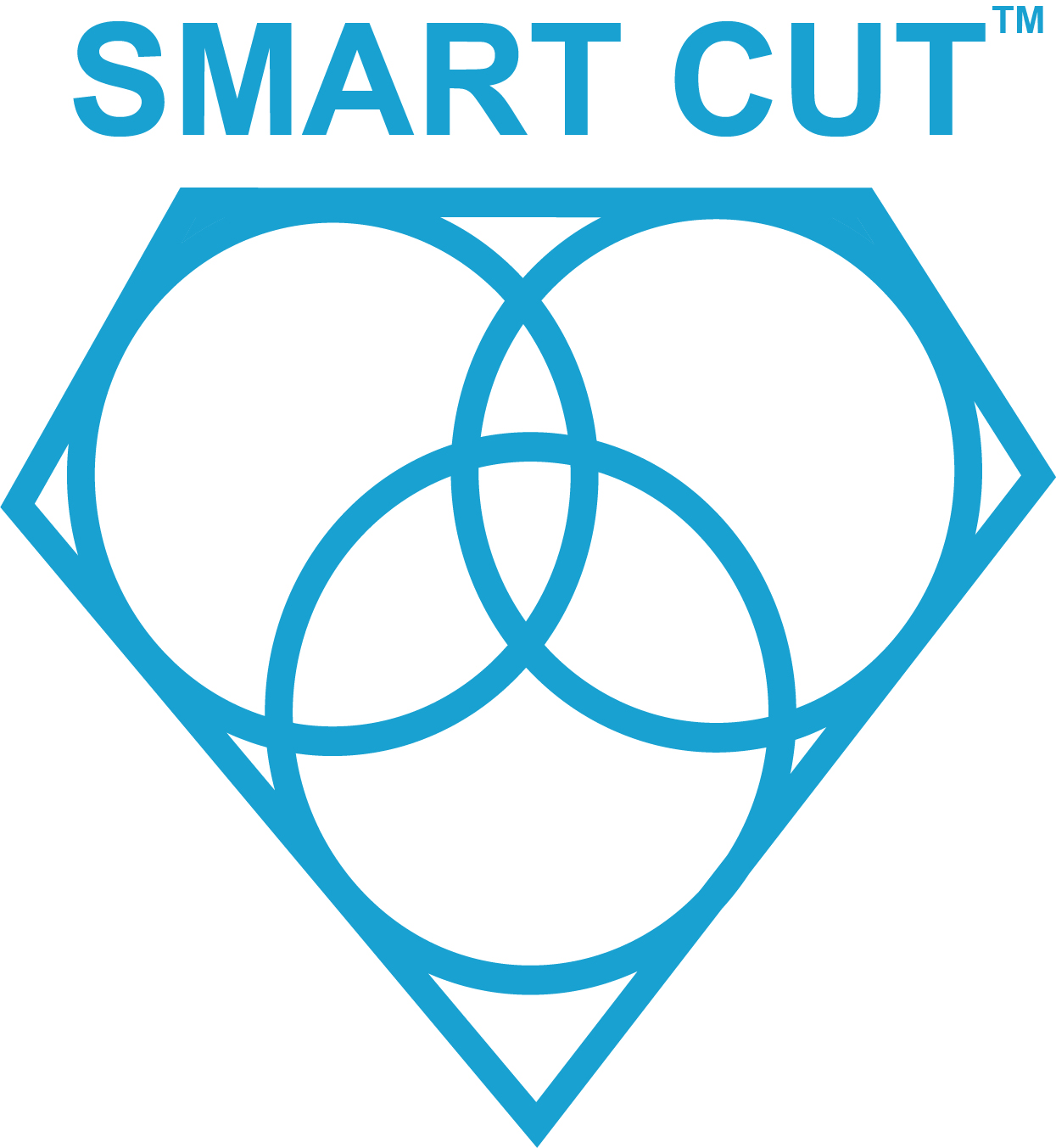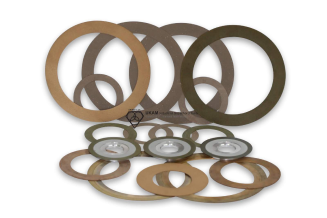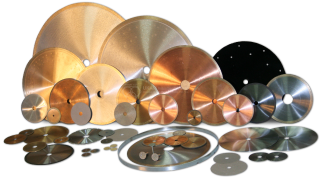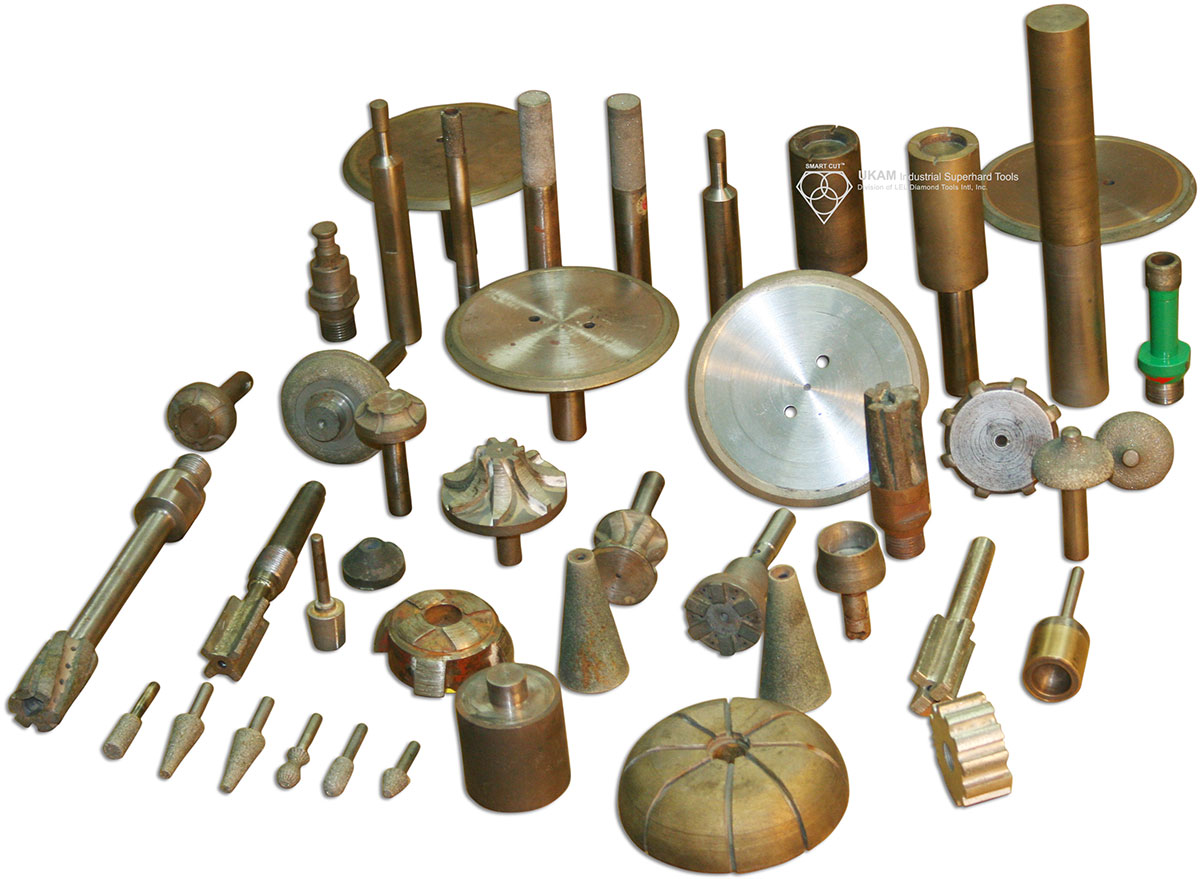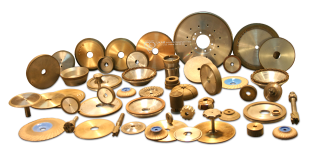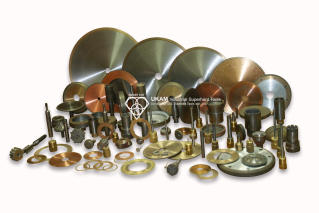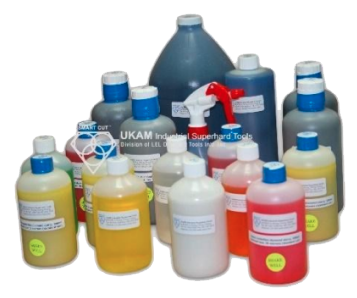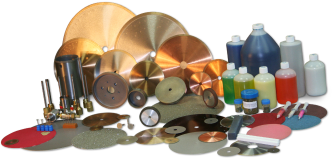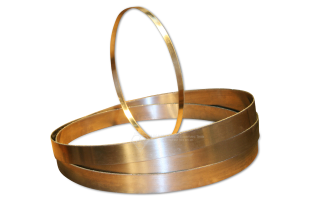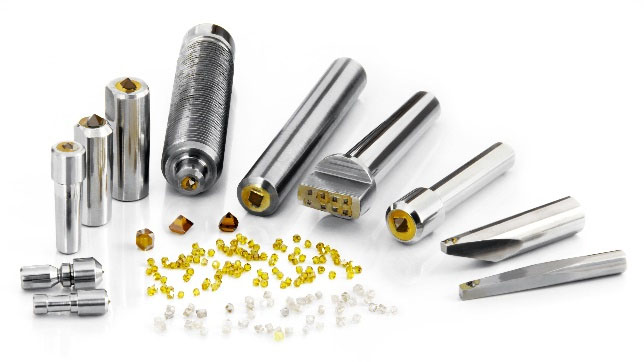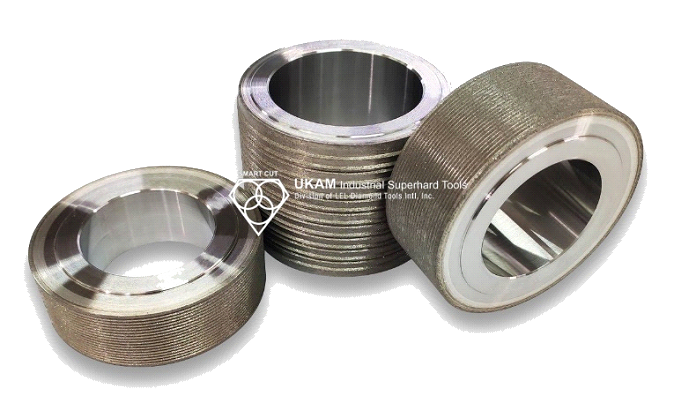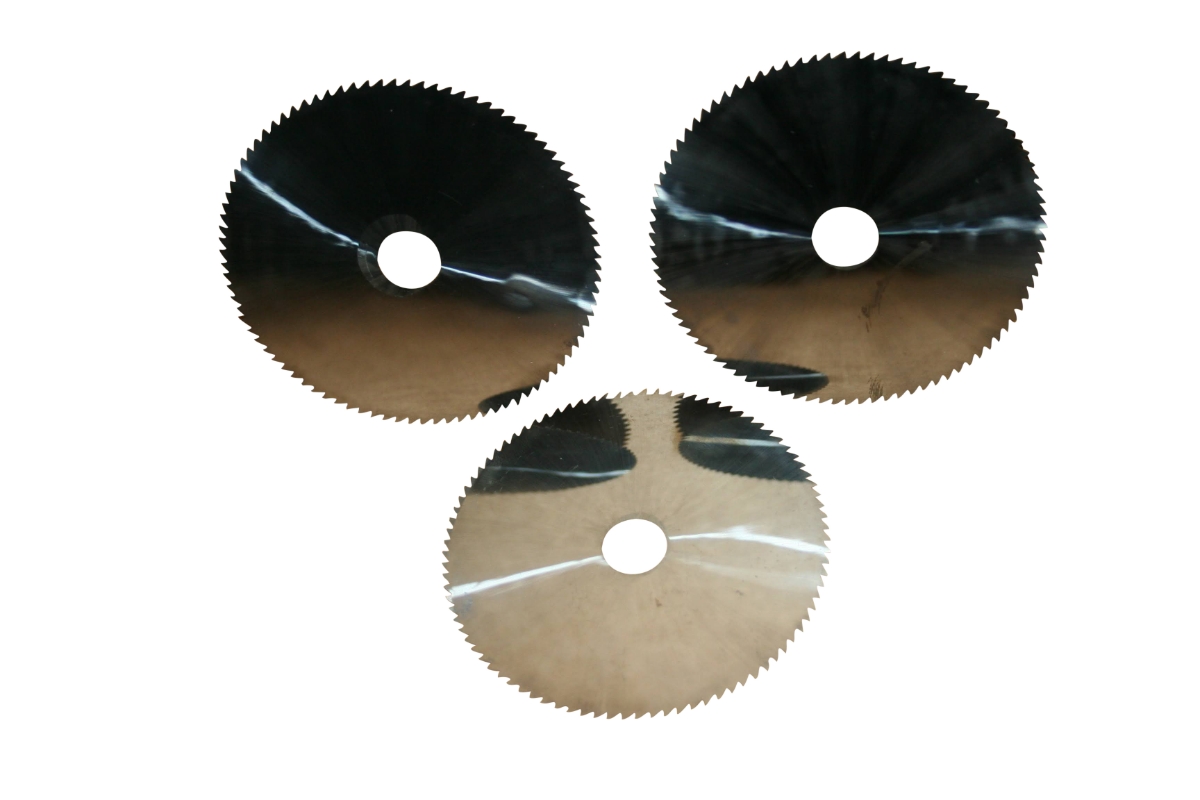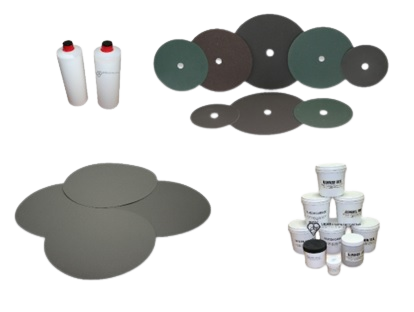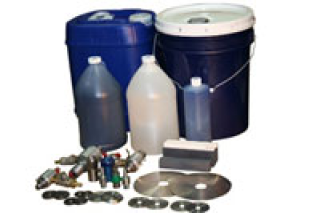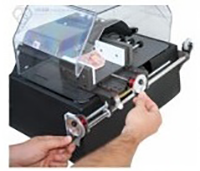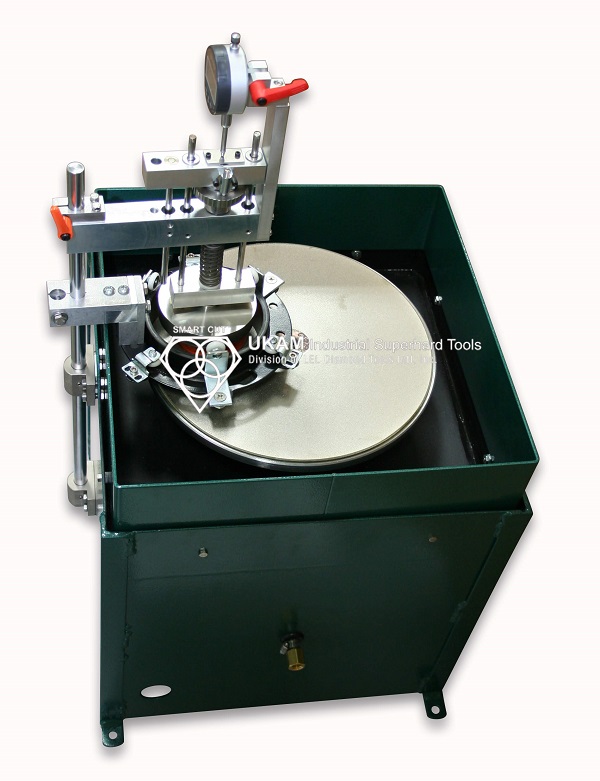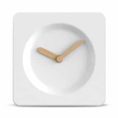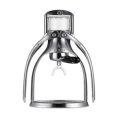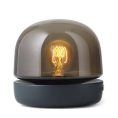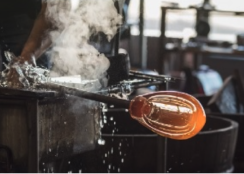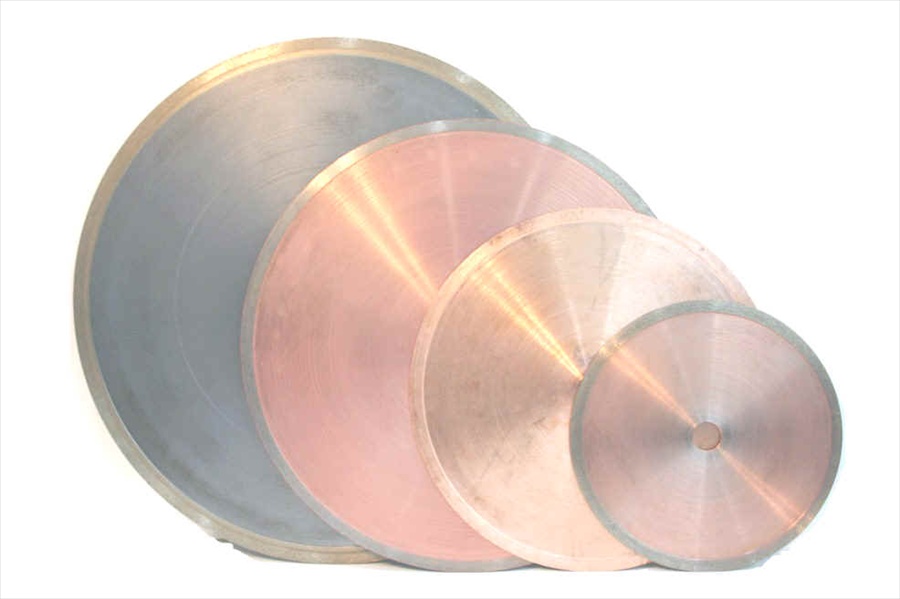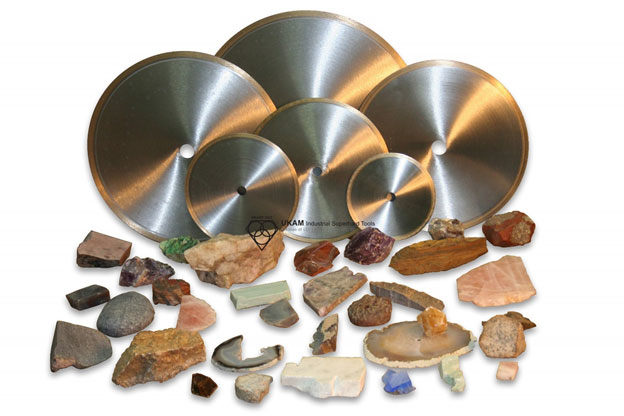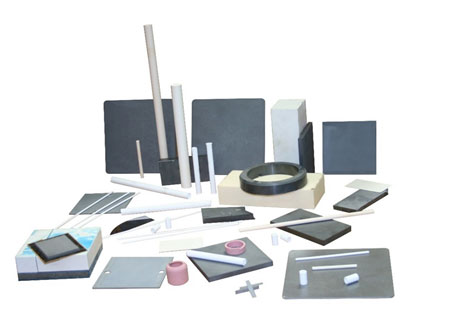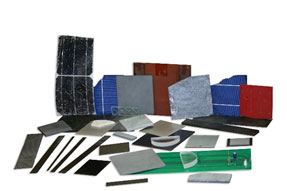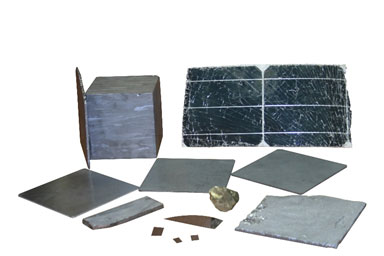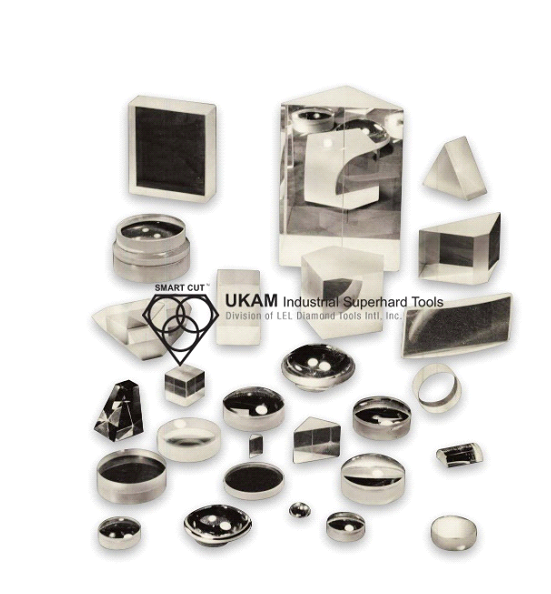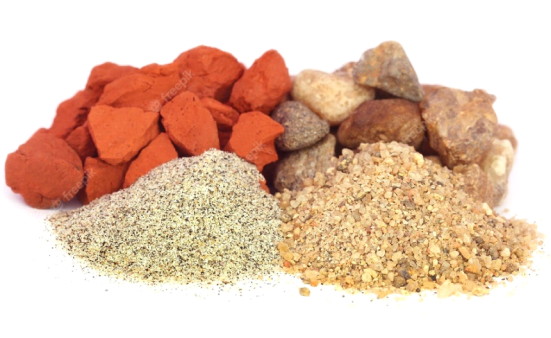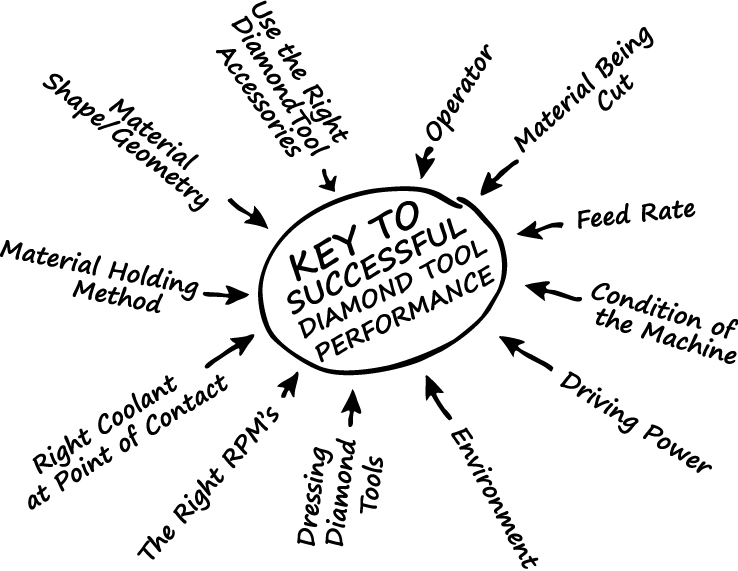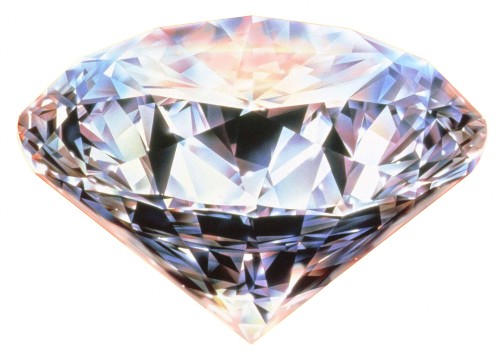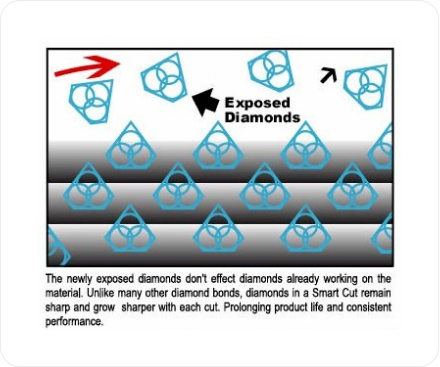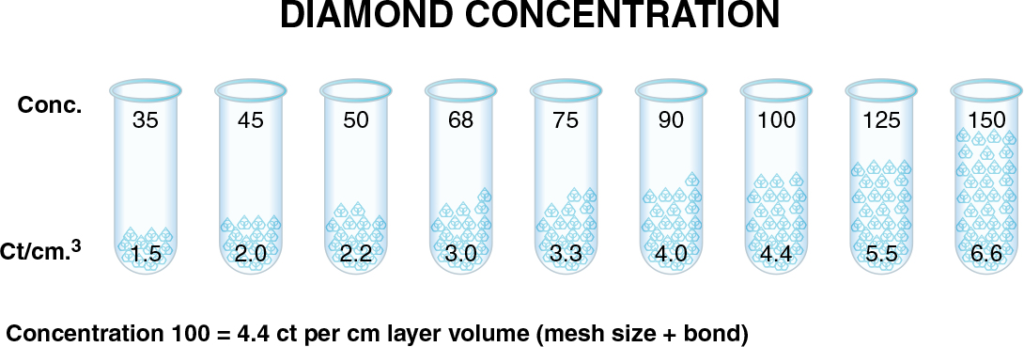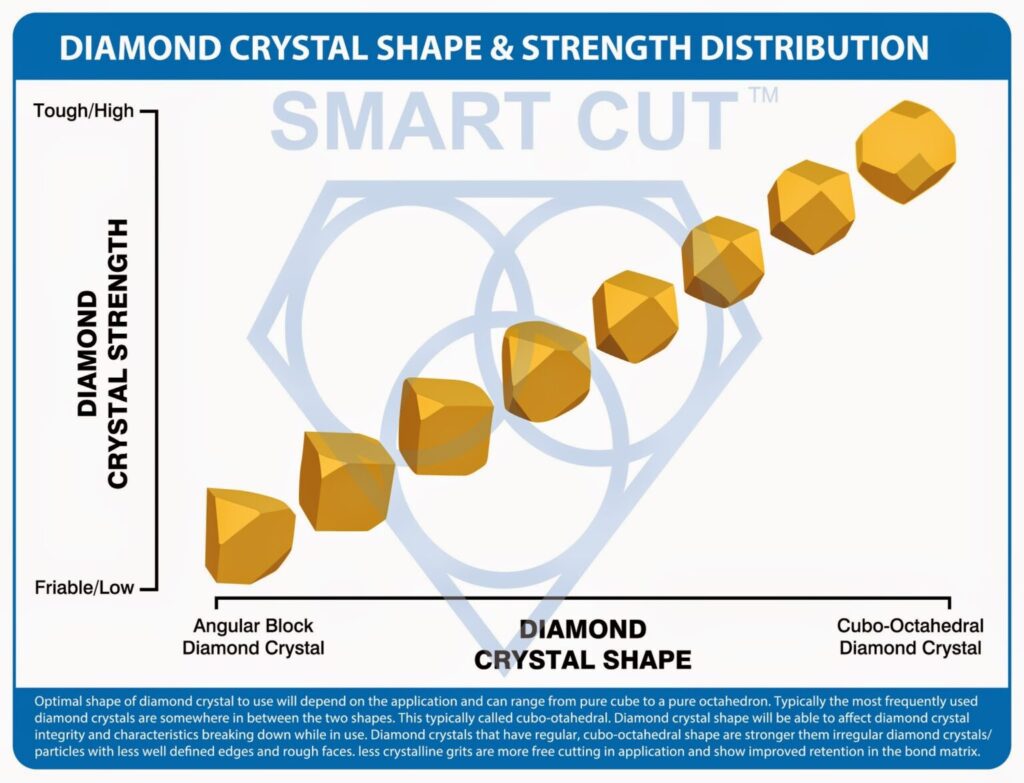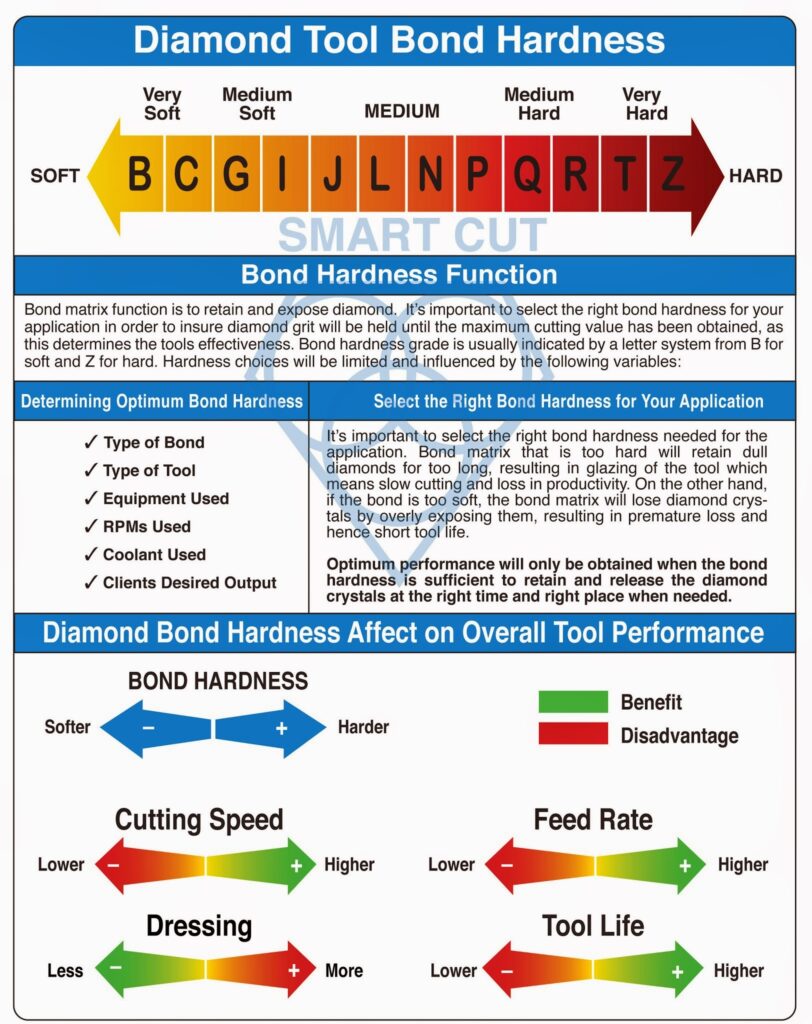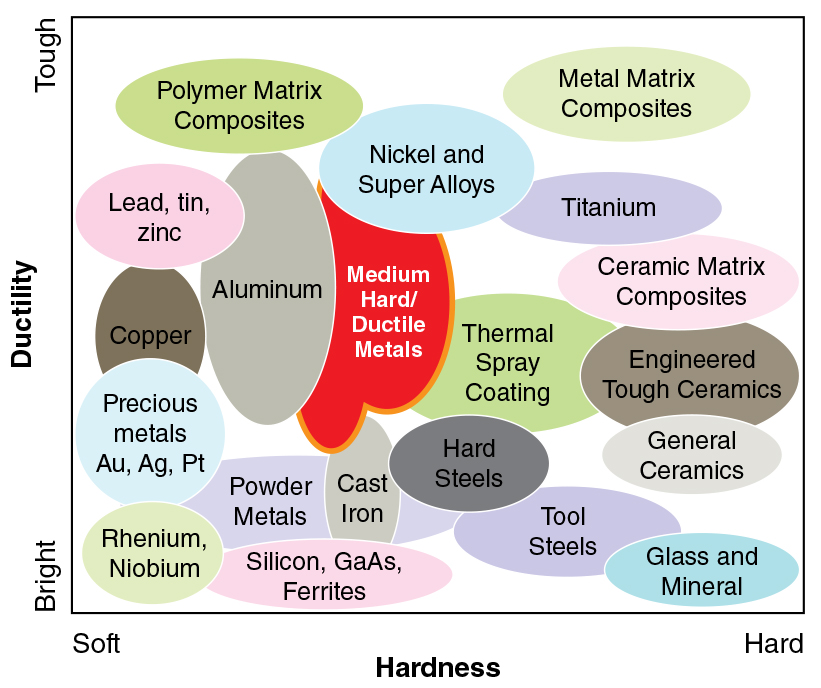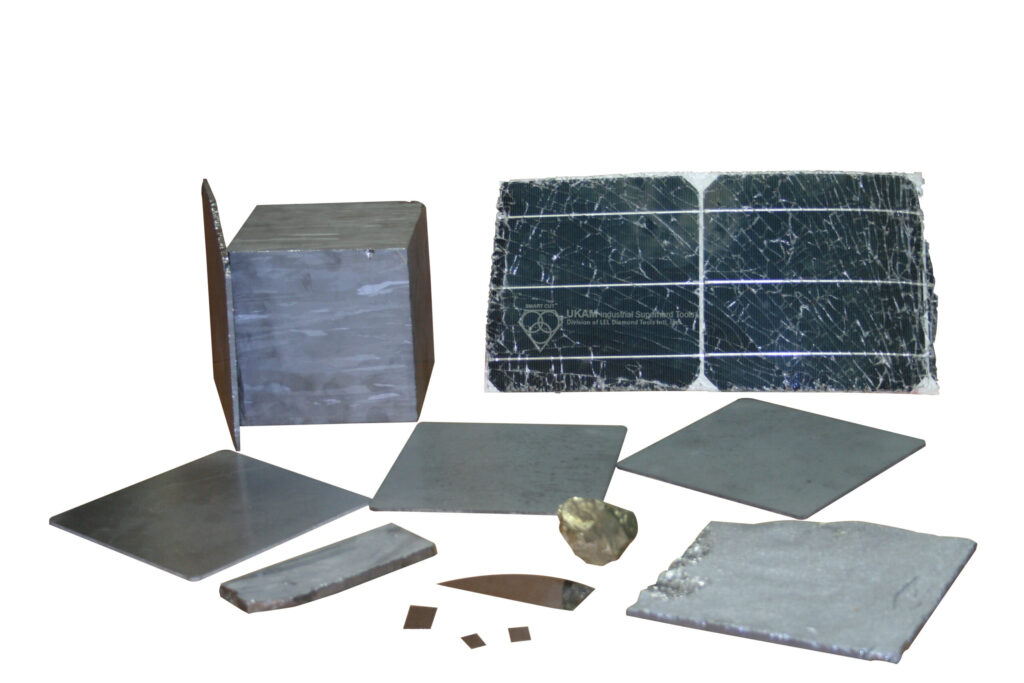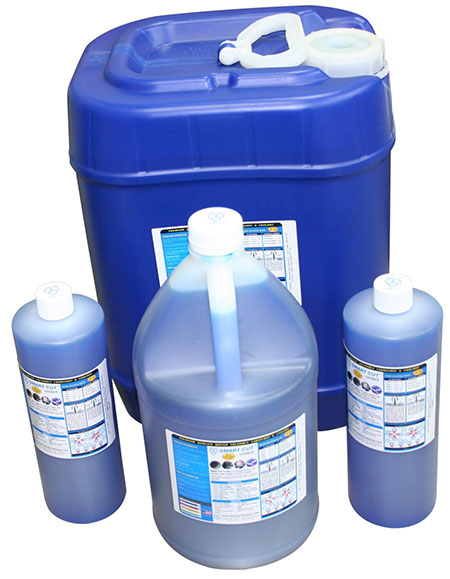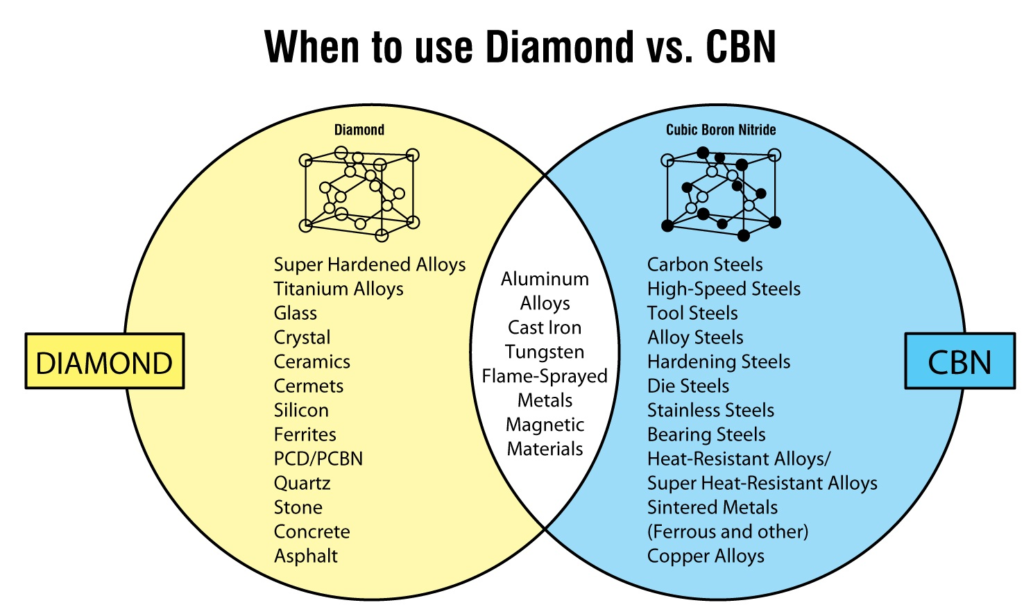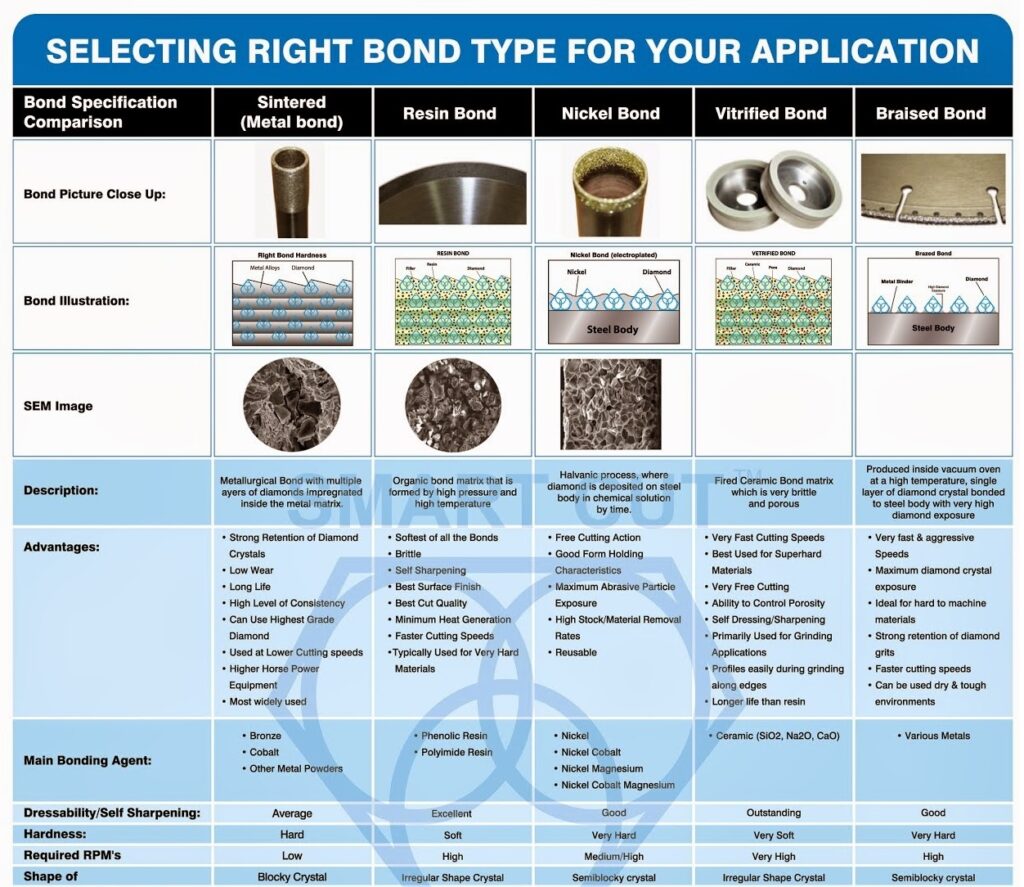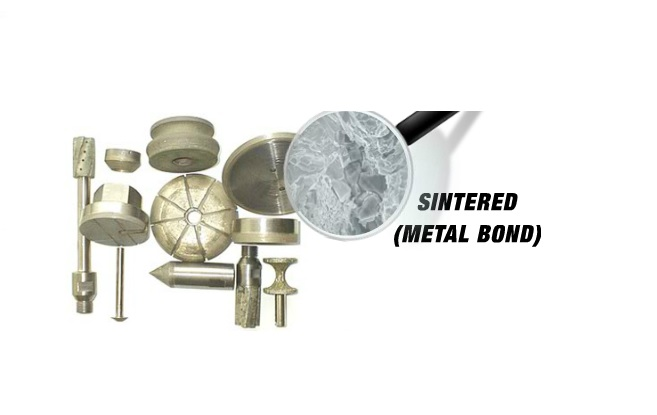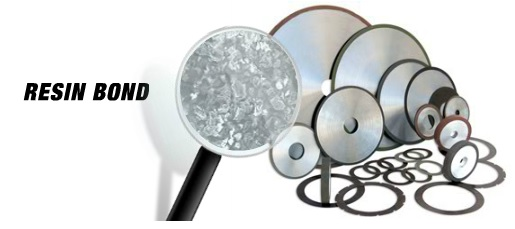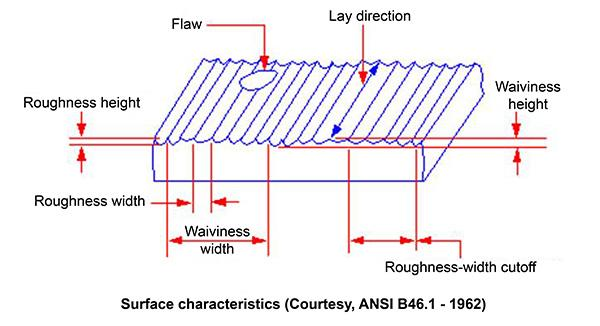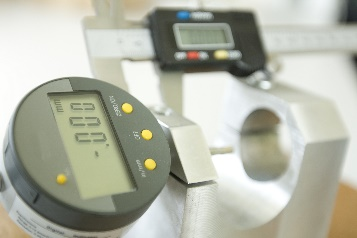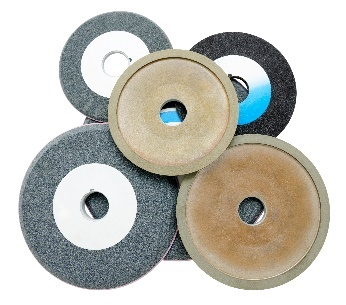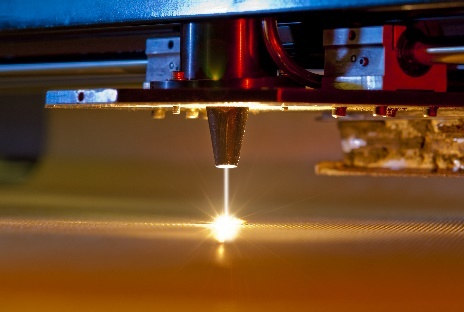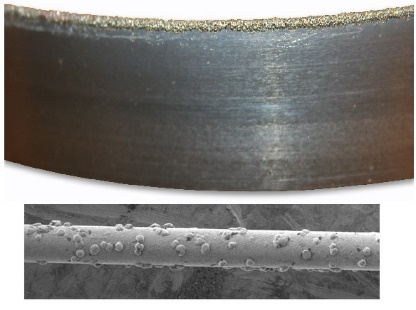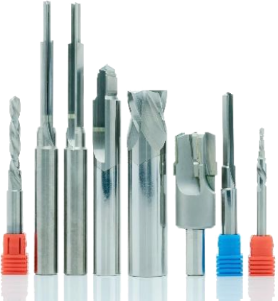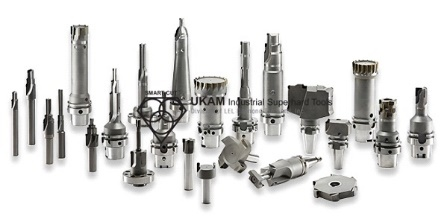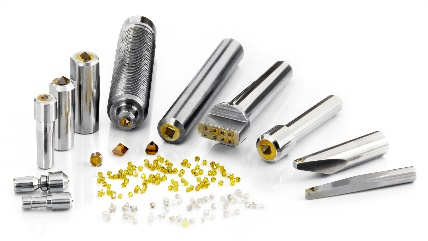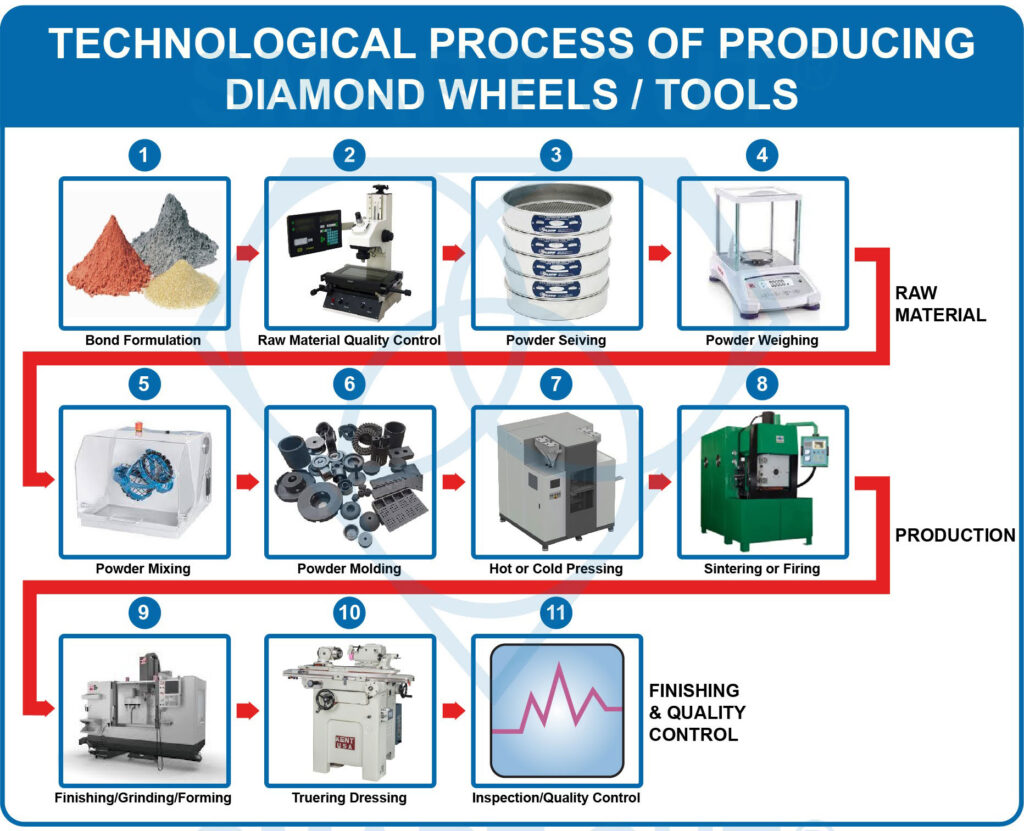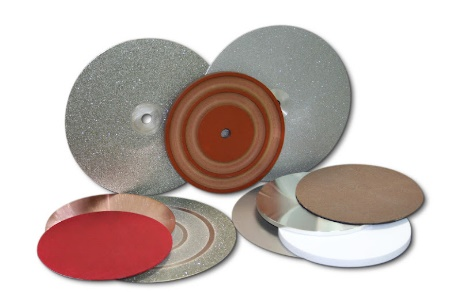The size of the diamond crystals, as well as the concentration, determines the amount of diamond that will be exposed above the cutting surface of the segments on the blade.

The exposure, or height, of diamond protrusion influences the depth of cut of each crystal, and subsequently, the potential material removal rate. Larger diamond crystals and greater diamond protrusion will result in a potentially faster material removal rate when there is enough horsepower available. As a general rule, when cutting softer materials, larger diamond crystals are used, and when cutting harder materials, smaller crystals are used.
DIAMOND IMPACT STRENGTH
Diamond crystal impact strength is one of the most factors in determining its suitability for use in most applications. Typically impact strength is determined by diamond crystals exterior integrity. If the diamond crystal is strong it will be able to cut through very hard and dense materials such a sapphire. On the other hand, weak diamond crystals can only be used for cutting soft materials such as glass. Greater impact strength is required for more harder to cut materials. Price of industrial diamond crystal is also based on impact strength as one of the main variables. The higher the impart strength of the crystal, the higher the cost. However, the higher impact strength is not always desirable for many applications. On some materials it will not make any difference. And in some cases, it can also decrease the effectiveness and overall performance of the tool.
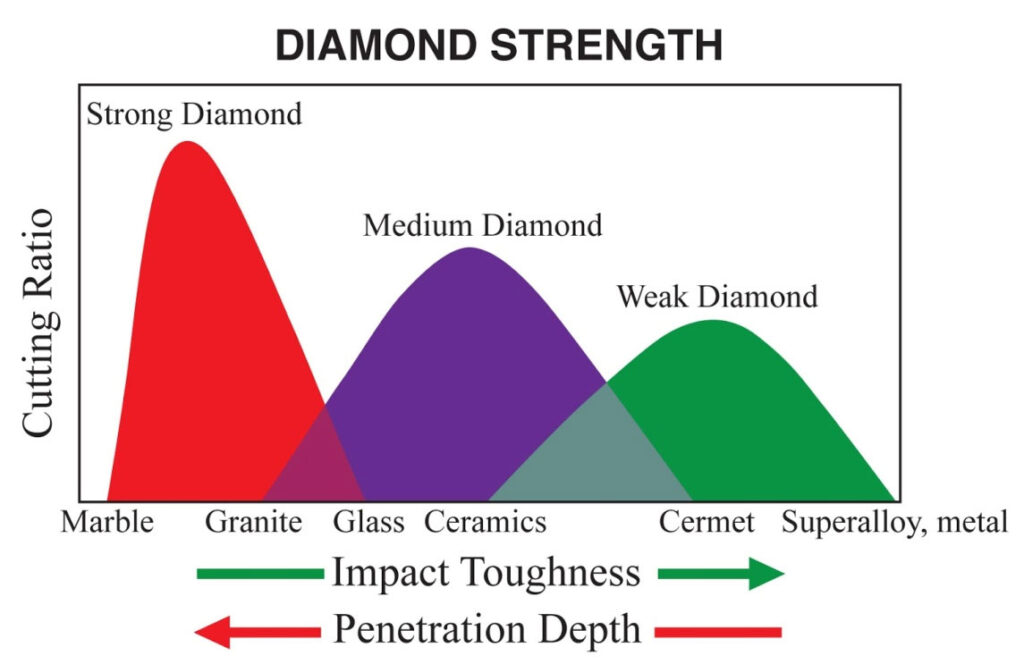
Diamond Crystal Impact strength is typically determined by its external integrity. A euhedral crystal is stronger than diamond crystal with rough surface. By same token blocky crystal is stronger then elongated crystal. Impact strength can be reduced if diamond is exposed to high temperature. Some of the important environmental factors that affect impact strength is themostability. Diamond crystal impact strength is measured by method call Toughness Index (TI)
BOND WEAR RESISTANCE
Wear resistance of the bond matrix has to correspond with abrasiveness of the material being cut in order for the diamond crystals to protrude sufficiently, but at same time not to fall out prematurely. A bond that is “too soft” will wear out faster then the diamond crystals it holds. Resulting in possible premature diamond crystal “pull out”. Opposite of very soft bond is a hard and wear resistance bond that wears more slowly then the rate the diamond crystal breaks down. Causing diamond crystal to glaze over.
Hard, dense, and brittle materials cause the bond matrix to wear slowly, since very little material debris is formed and only as a fine powder. However, when cutting soft, gummy, gritty, and open textured materials a large quantity of coarse and more blocky which causes much faster wear of the bond matrix.\\
DIAMOND RENTENTION CAPACITY
The second most important function of the bond matrix is to hold diamond crystals firmly in place
DIAMOND STRENGTH
An overly strong diamond crystal will either be broken or lost, but an overly wear diamond crystal will be disintegrated too fast. For this reason diamond crystal strength must be adjusted to suit the impart force in such a way that micro chipping is the dominant mode of wear and occurs more slowly
Diamond crystal wear mechanism is dependent on diamond strength. In order to optimize the cutting performance in both cutting ration and cutting speed, diamond crystal loss must be turned to micro chipping at the expensive of smashing and pullout/micro fracture.
If a tough diamond crystal is used to cut hard material will either be broken or it will be knocked off the bond matrix, depending on bond matrix hardness in comparison to diamond crystal. IF a diamond that is friable is embedded in a cushion
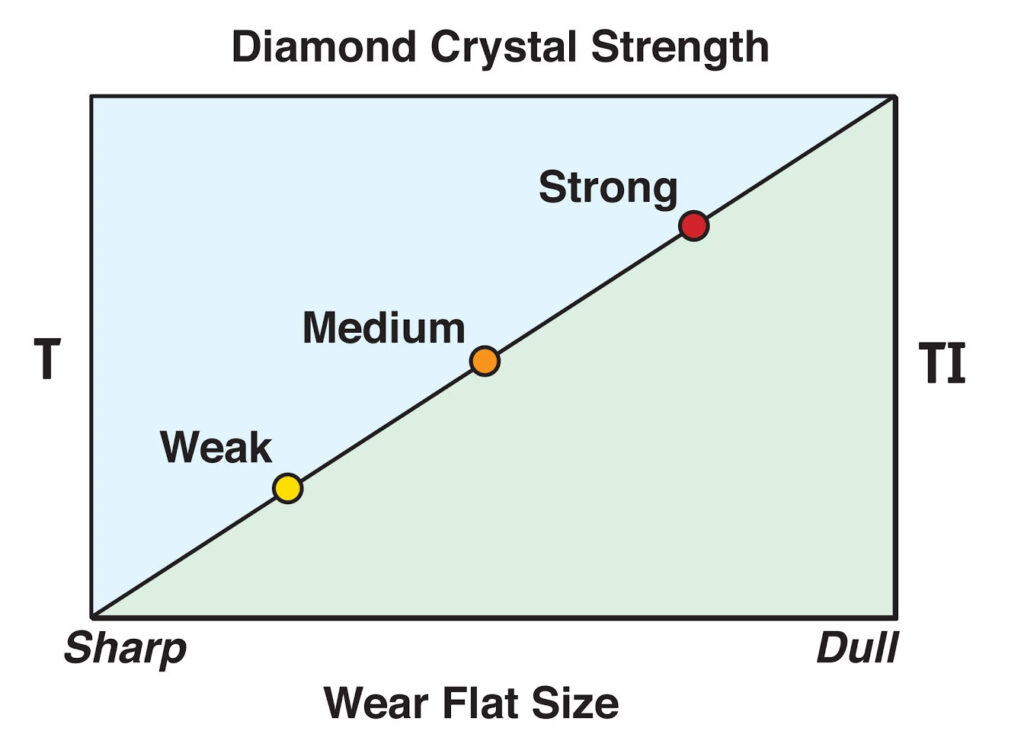
like a resin bond matrix and used to cut very hard material. Friable diamond will provide best level of performance at smaller cutting depth. With deeper cutting depth the diamond crystal will be smashed quickly, yet with smaller cutting depth this diamond will stay sharp by forming microchips gradually. In this matter the shaper diamond crystals can penetrate the hard material and cut it in most efficient mater, by utilizing electrical energy. Diamond friability will increase with increasing toughness of the material. Here is each diamond crystal can cover a certain range of toughness. Diamond crystal will develop a wear flat and become too dull to penetrate
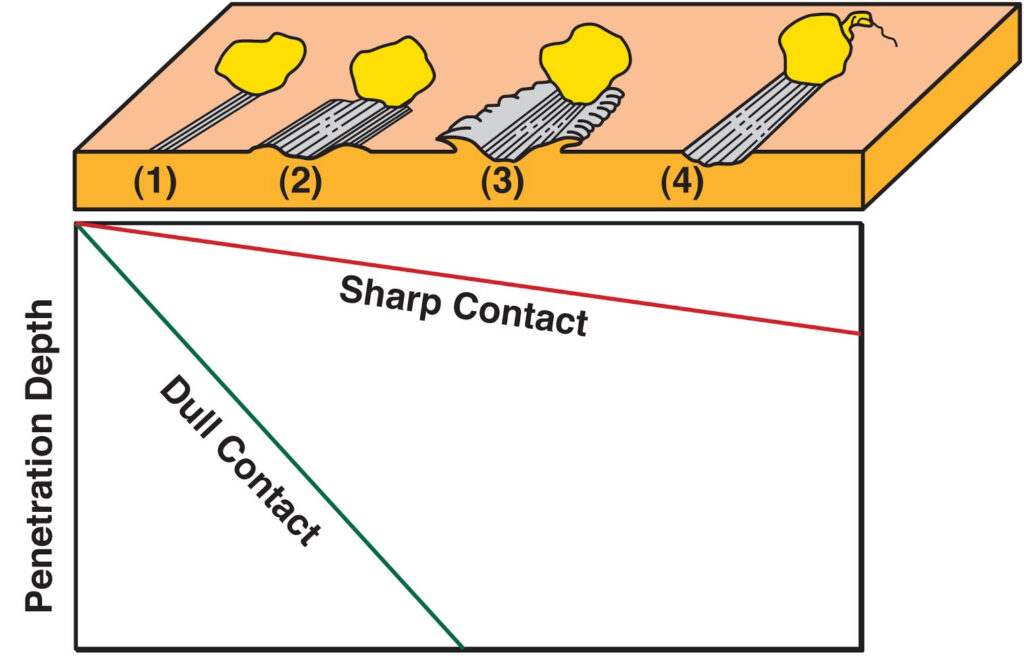

Diamond crystal penetration depth will determine its level of functionality and utilization, and hence the level of the diamond tool performance. The optimal diamond crystal penetration depth is to allow the diamond crystal to microchip gradually. However the penetration depth will depend on the properties of both diamond crystal and material being cut. Diamond crystal penetration depth will be shallow with weaker diamond, specially when working with very hard material such as advanced ceramics, and deeper with strong diamond crystal when cutting through softer materials such as glass or tile.
Diamond is the hardest material known to man kind. So it can be used to cut into any type of material. Diamond crystal can cut into any Soft and brittle materials such as glass or soft stone, without being broken or pulled out. On the contrary for hard and dense materials the diamond crystal must sharpen itself by forming smaller microchips. This will reduce the contact pressure between diamond crystal and material, allowing diamond crystal to penetrate freely.

DIAMOND CRYSTAL WEAR MECHANISM
The capability of the diamond crystal to penetrate into the material, will depend on the contact pressure (feed rate) amount of force applied. With higher amount of force applied the diamond crystal will increase its penetration depth. At first the material at point of contact will be deformed, then gradually broken. This is the definition of diamond grinding action. The rate at which the diamond crystal penetrates will increase rapidly with the development of the wear flats.
A sharp diamond crystal can cut easily, however diamond crystal with large wear flat faces, will increase amount of resistance force between the material it comes in contact. The challenge in this scenario is the kinetic energy will be distributed more towards heat generation then to cutting the material. As a result not only the grinding sped will be reduced, but the diamond crystal may fail due to large impact force at high temperature. A diamond crystal that is too strong will either be broken or lost but a very weak diamond crystal will be smashed quickly. For this reason diamond strength must be tailored to suit the impart force to the extent where micro chipping is the dominant mode of wear in a controlled matter.
DIAMOND CRYSTAL SELECTION
Diamond crystal must have enough strength to withstand the impact force of cutting a material. At the same time the diamond must not be too strong to prevent it from micro chipping after it has been worn out. Diamond crystals that are too strong may develop a large wear flat that will prevent it from cutting effectively. For this reason diamond crystal strength must be controlled to allow micro chipping.
Typically the diamond crystals used for industrial diamond tool application have many different types of defects such as surface roughness, metal inclusions, and micro fractures. In many cases, the less defined the diamond crystal form, the more metal inclusions and other defects in can have. These types of diamond crystals are weaker and are less thermally stable. As metal inclusions present in the diamond crystal can waken it at high temperatures. Not always is this an undesirable outcome. In some cases properly controlled distribution of metal inclusions can be used to create sharp cutting edges that are formed by increasing contact force with the material due to the dullness of the cutting tip. This shelf sharpening characteristic is very important for a number of applications, specially for ultra hard and dens materials.
Diamond crystal surface condition
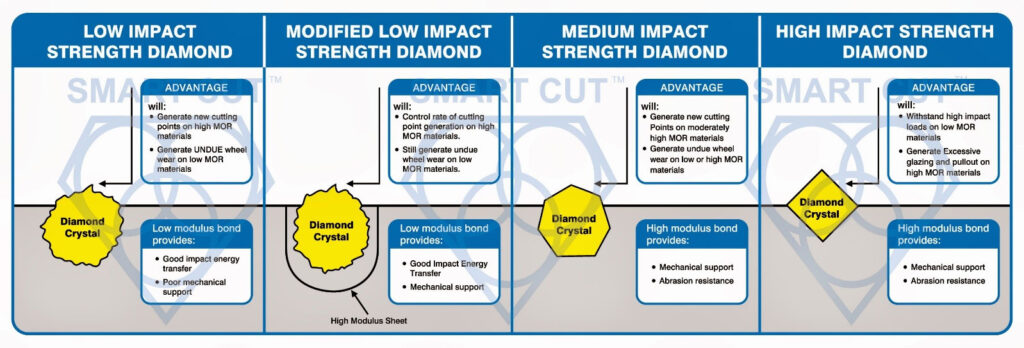
Typically the diamond crystals used for industrial diamond tool application have many different types of defects such as surface roughness, metal inclusions, and micro fractures. In many cases, the less defined the diamond crystal form, the more metal inclusions and other defects in can have. These types of diamond crystals are weaker and are less thermally stable. As metal inclusions present in the diamond crystal can waken it at high temperatures. Not always is this an undesirable outcome. In some cases properly controlled distribution of metal inclusions can be used to create sharp cutting edges that are formed by increasing contact force with the material due to the dullness of the cutting tip. This shelf sharpening characteristic is very important for a number of applications, specially for ultra hard and dens materials.
DIAMOND GRIT SIZES
Both natural and synthetic (man made) diamond are classified into two board bands of grit sizes. These are frequently called "saw" and "wheel" grits. Each grit size can be narrowed down to a band, which is defined by tow sieve aperture sizes (top and bottom).. Many diamond grit sizes are also characterized by particle per carat count. This guarantees the number of particles per carat to straight tolerance for each mesh size, helping insure high degree of consistency.
different industries, applications and types of tools used different diamond grit sizes. Below is an application example relative to grit size range:
Diamond Grit Size Range
Application Example
20/30 Mesh
Diamond sawing and drilling of very abrasive materials. Such as sandstone, concrete, asphalt. Drilling of Reinforced concrete, frame sawing of abrasive sandstone
30/40 mesh
Diamond sawing and drilling of stone, concrete, reinforced concrete and asphalt. Frame sawing of abrasive sandstone |
40/50 Mesh
Diamond sawing, drilling and milling of stone (granite, diorite, gabbro, less abrasive sandstone, limestone, dolomite, marble), concrete and refractoriness; wire sawing of stone and construction materials; calibrating of stone slabs
50/60 Mesh
Diamond sawing, drilling and milling of stone (granite, diorite, gabbro, less abrasive sandstone, limestone, dolomite, marble), concrete and refractoriness; wire sawing of stone and construction materials; calibrating of stone slabs
60/80 Mesh
Diamond sawing, drilling and milling of glass, calibrating of ceramic tiles
Coarser diamond grit sizes typically protrude more for supporting bond matrix so they can cut into the material faster. This results in greater clearance and enables easier swarf ejection when larger material has to be removed per tool revolution. Diamond grit size selecting is a compromise between cutting speed (quantity) and surface finish (quality). Optimum results will be found where maximum material cutting rate at minimal acceptable surface finish.
For a number of applications, optimum results cannot be achieved within a single step. In this case two or several steps will be needed. First material will be ground, and then polished by finer diamond grit sizes until desired surface finish has been achieved. Coarser diamond grit sizes also tend to last longer.
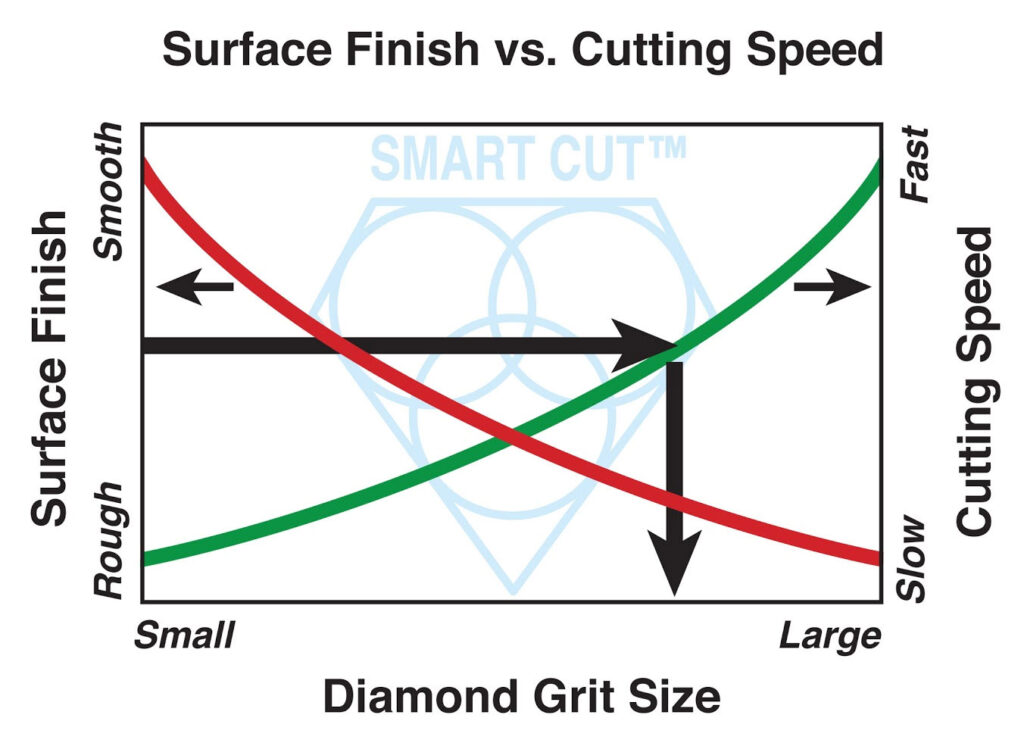
How Diamond Grit Size is Classified
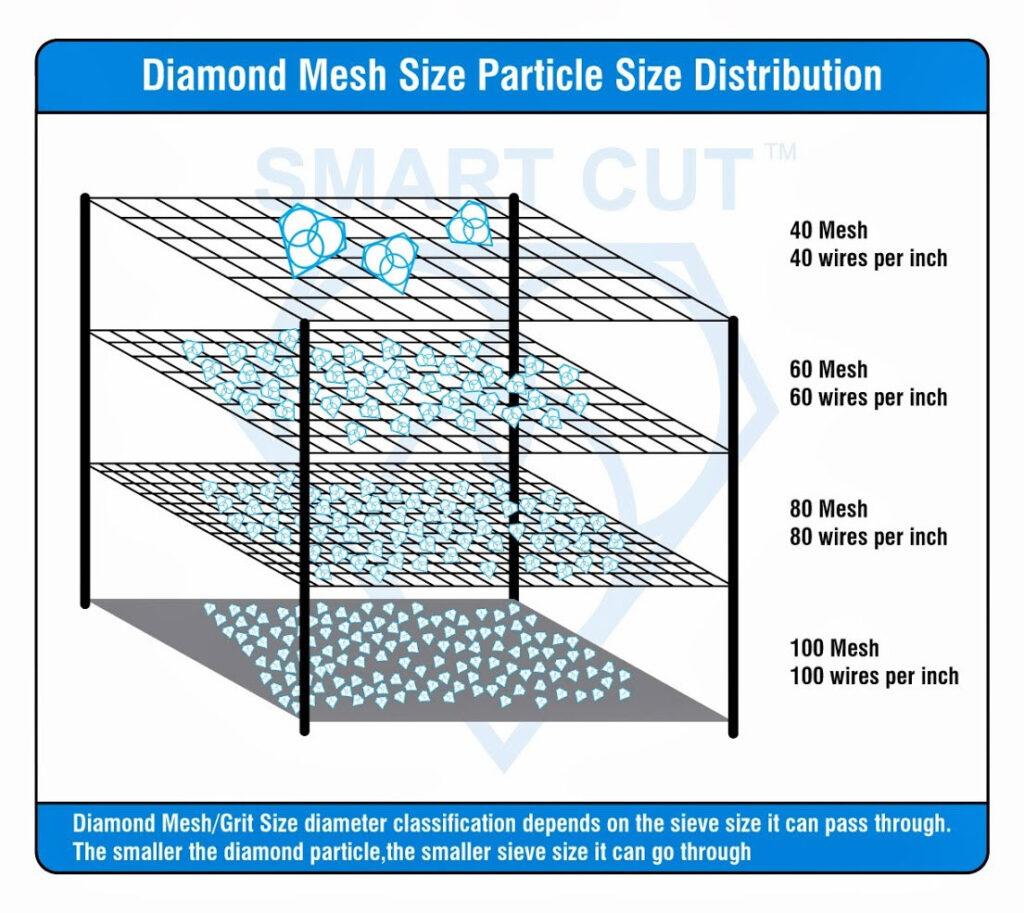
Diamond Crystal is first classified by size. To determine each crystals size, sieving process is implemented. A sieve is made from cross weaving of metal wires (usually stainless steel) that have very consistent shape and size square holes. Diamond crystals are bounced around these holes within pre determined amount of time in order to separate them in two patches. Those that passed the sieve (went through) and those that were left behind on the screen.
The sieve holes are determined by specification set forth by either American or European standard. American use ANSI (American Nation Standards Institute) Specifications,
and their European counterparts following FEPA. The American system sets the standard for sieving based on number of holes per inch of screen wire, this is what is referred to as mesh size.
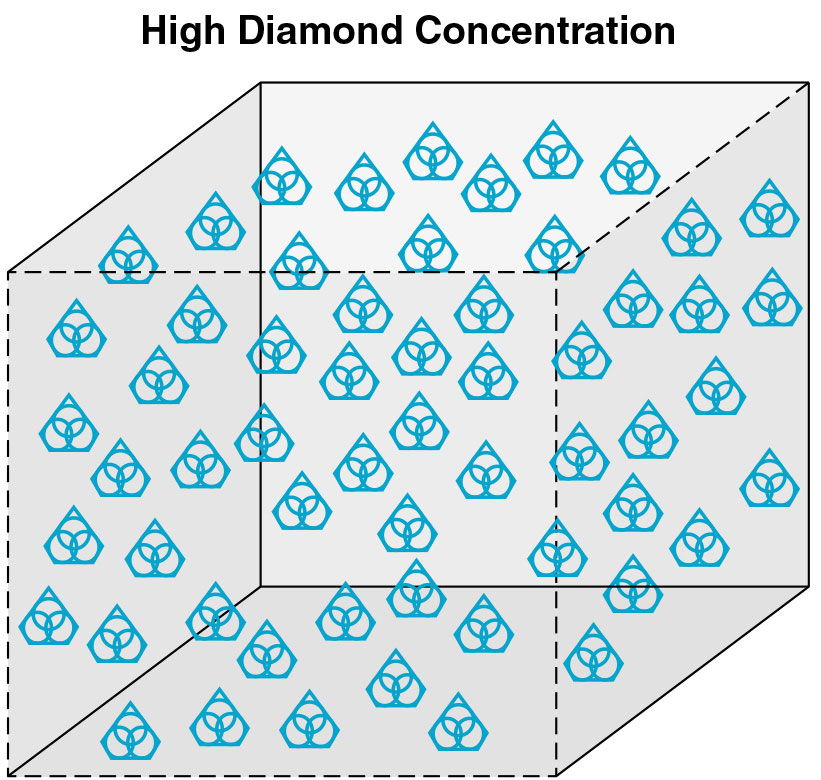

In many applications the life of the diamond tool is primarily controlled by amount of diamond crystal in the bon matrix. This amount is called “diamond concentration”. Diamond concentration can be defined as volume fraction of diamond crystal in bond matrix. Hence, the higher the diamond concentration a diamond tool has, the longer its life time. The trade off is slower cutting speeds, due close spacing of diamond crystals in the bond. The level of the diamond crystal exposure is reduced as well, possibly causing rubbing of bond matrix against material being cut. This side effect causes increase in temperature and burning of material or tool, or often both.

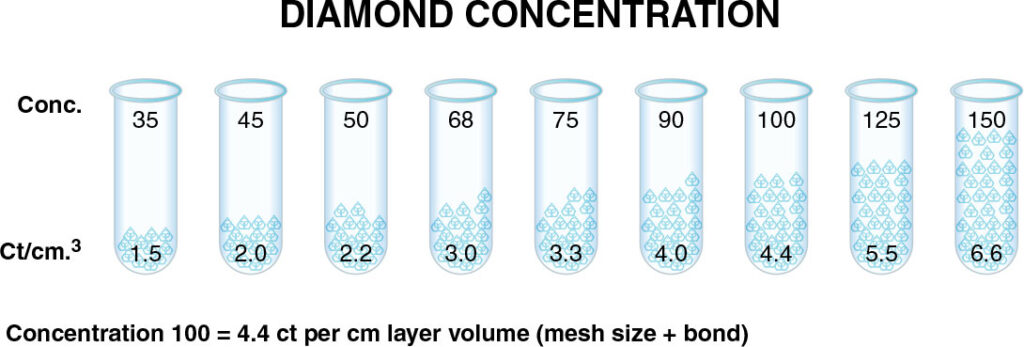
“Diamond concentration is determined by the slowest cutting speed that is acceptable for achieving certain objective”
low diamond concentration typically makes the diamond crystals highly vulnerable because of the increased impact force on the over exposed diamond crystal. As a result the diamond crystal is used too fast, causing the cutting speed to drop below acceptable level quickly. For this reason there is optimum diamond concentration to use in correlation to each diamond grit size.
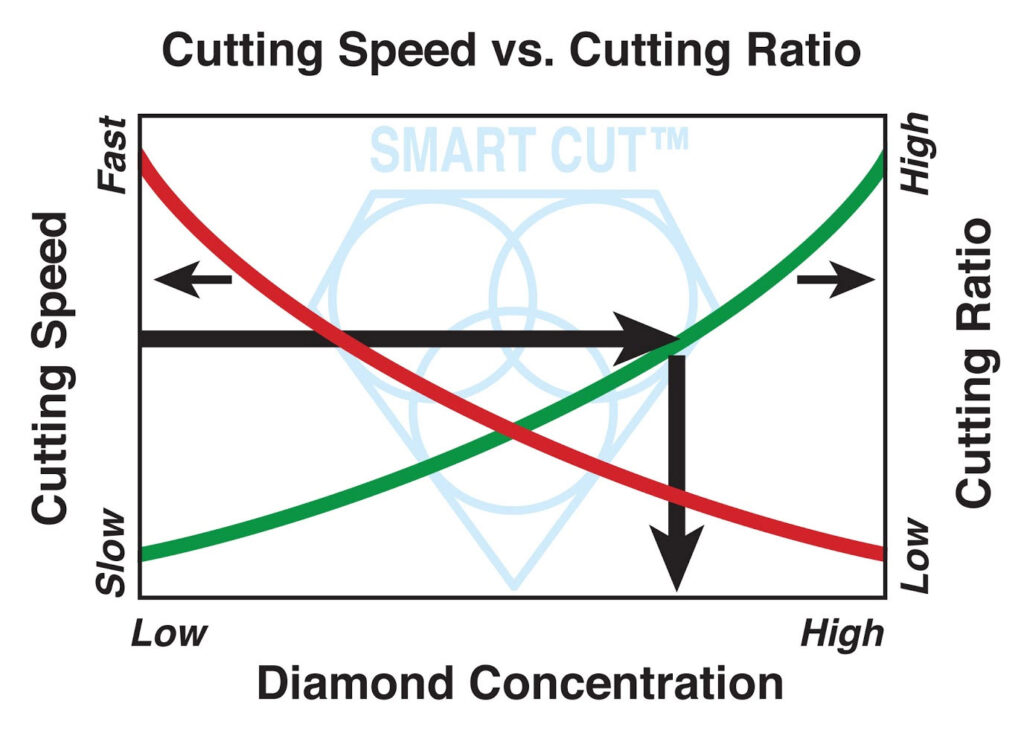
OPTIMUM DIAMOND TOOL PERFORMANCE
Optimum diamond tool performance is measured by efficiency, cost and ease of the application. These may be further defined by optimum cutting speed, tool life, and power consumed. Not only the technical specifications of the diamond tool must be well chosen, but the equipment and process used must support the necessary cutting parameters.
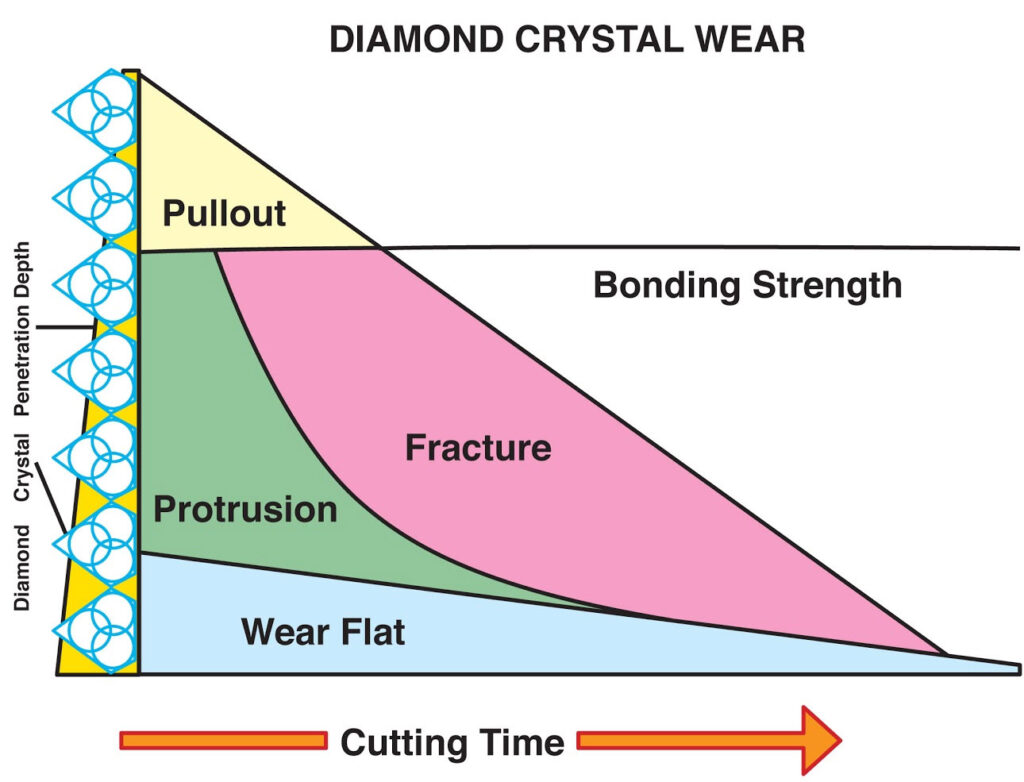
Diamond tool performance is dependent on diamond strength, bond matrix hardness, and hardness and properties of material. Diamond crystal strength will shed light on its mode of fracture. If the diamond crystal forms a wear flat, it is too strong or cutting conditions to mild for the application. On the other hand if the diamond crystal is shattered, the diamond crystal is too weak or operation is too tough.
Optimum mode for diamond crystal wear is micro chipping
with this method the diamond crystal is able to renew the sharp cutting edges it needs for cutting with maximum efficiency.
DIAMOND CRYSTAL PROPERTIES
Most diamond crystals are usually smaller then 1mm, and are barely visible with naked eye.
Almost all industrial diamond crystals are rough on surfaces, as they have many flaws and impurities. Out of all industrial diamonds, Coarse saw grade diamond crystals have the largest diamond grit size available (20 to 50 mesh) or (1mm to 0.25mm). And have the highest degree of perfection possible for industrial diamond crystal. They are usually euthedral in shape, with fully crystal crystallographic faces and have interiors that posses very little defects or inclusions.
Advantage of this type of diamond crystal is that its able to cut material at hih sped and break the material by brutal force. Smaller size diamond crystals work by scratching the material slowly and gradually. Unlike, their larger counterparts, they rely more on their hardness (not on toughness to smash) to penetrate the materialIndustrial diamonds are available in large variety of grades and prices. All industrial diamond makers can produce low grade diamond (low strength and small size). However only a few can make high grade diamond.
Diamond crystal size - usually determines the cutting tools speed and surface finish roughness.
Diamond crystal strength – usually determines the materials it is able to cut and the cutting parameters (such as the RPM’s) it can run
Diamond crystal thermo stability – usually determines the processing temperature (such how the diamond can be applied and which type of tool). As well as aggressiveness of the cut (penetration depth).
Diamond crystal shape – usually determines cutting speed and resistance of material being cut
Diamond crystal surface condition - usually determines the diamond crystals adhesion and retention strength in the bond matrix. In many cases if the diamond crystal has many inclusions and / or imperfections, this can cause the diamond crystal to become prematurely dislodged in bond matrix and fall out or disintegrate before being used.
NATURAL DIAMOND
Carat
Color
Clarity
Cut Charm
SYNTHETIC DIAMOND
Size
Strength
Stability
Shape
Surface
DIAMOND CRYSTAL COATINGS
In a number of applications, diamond crystals can be coated in order to improve their retention in the bond matrix. Coated diamond crystals also offer higher protrusion ration, hence providing faster cutting speed. Longer diamond crystal retention in the tool bond matrix have been shown to provide at least 1/3rd longer life. Usually the coatings consist carbide material components, capable of forming carbide with diamond crystal at the surface. These include Ti, Cr, W, SI. The coatings are applied through several methods. These include vapor deposition, chemical reaction and / or diffusion in fused salt bath. Each method has its advantageous and limitations.
DIAMOND TAILS
Diamond crystal tail shields the crystal so it can be held longer in the bond matrix, preventing them from becoming pre maturely dislodged or falling out before having been used.
Cutting in opposite direction will erode the tail, causing the diamond crystal to be overly exposed and knocked off as it comes in contact with material.

